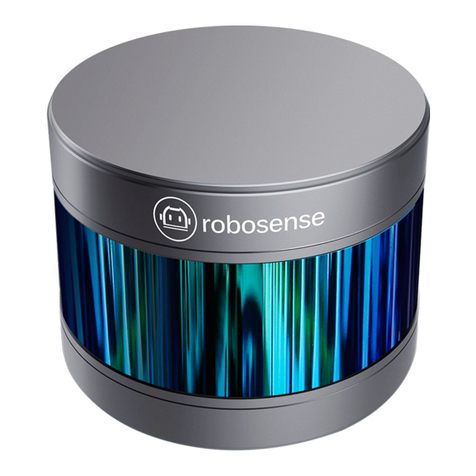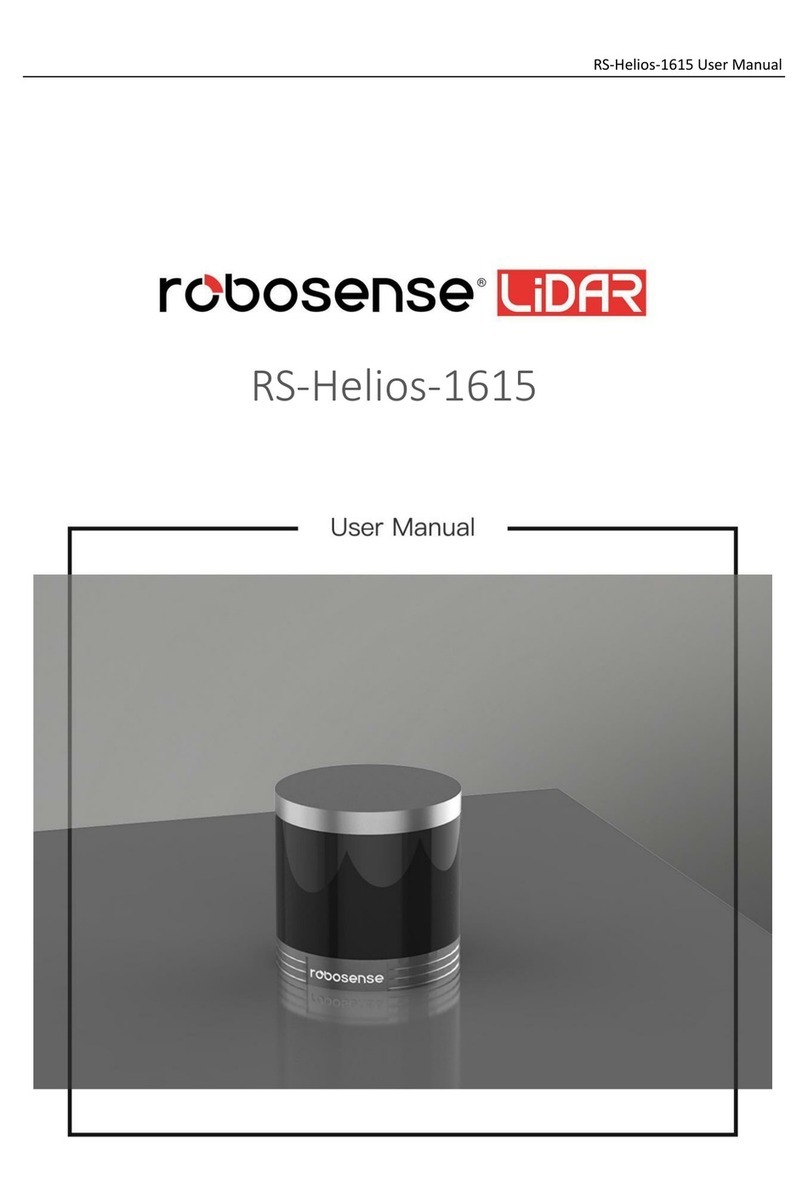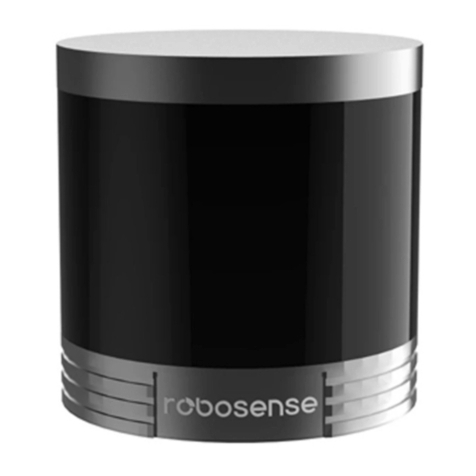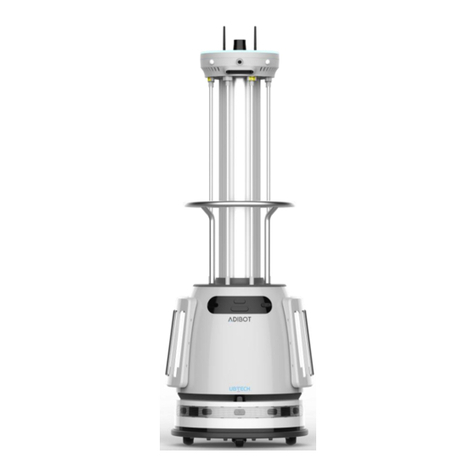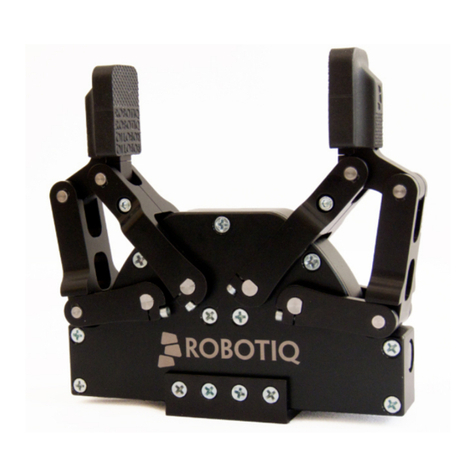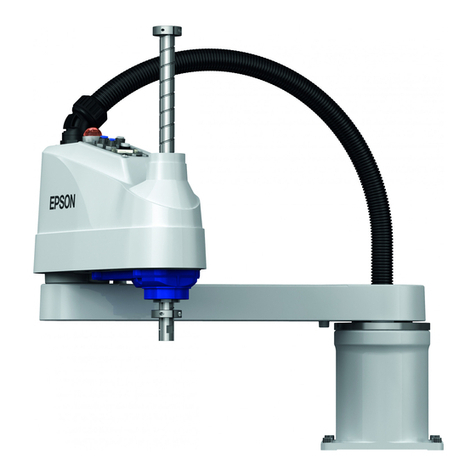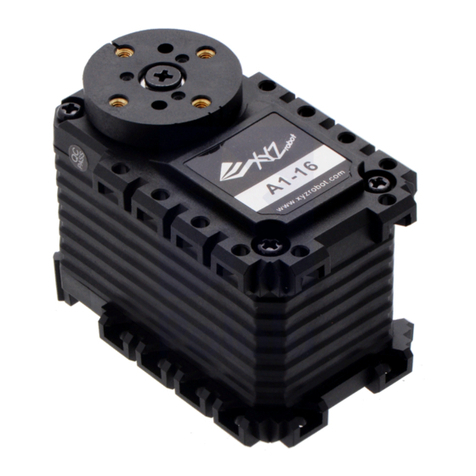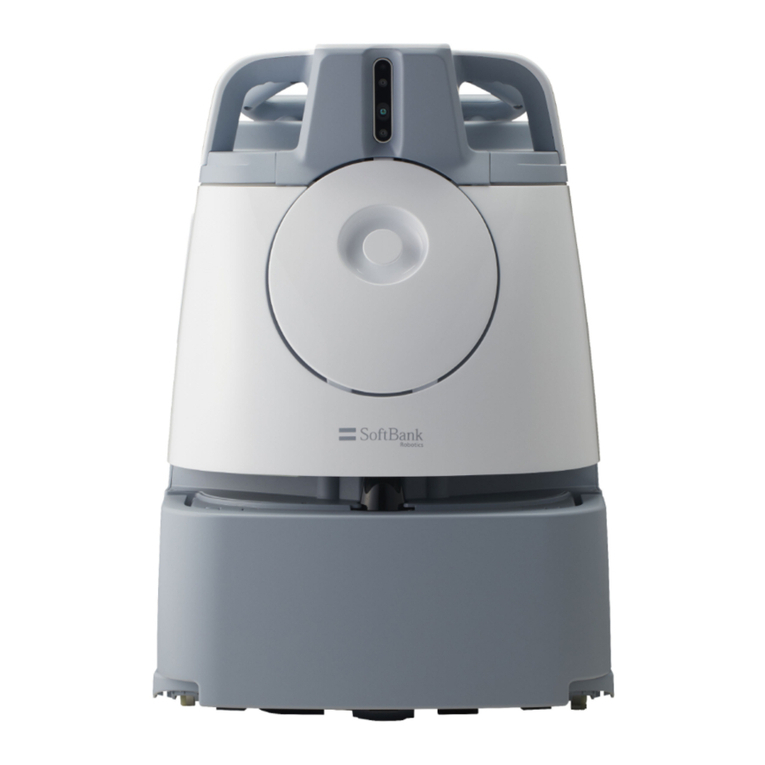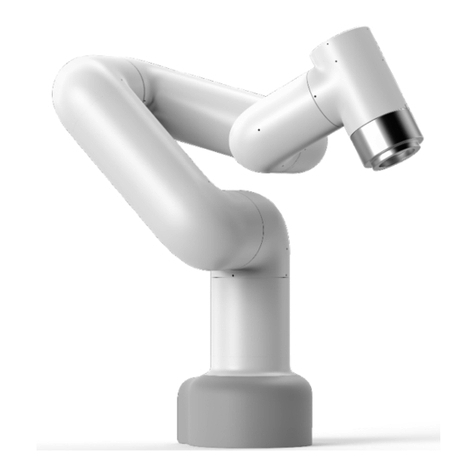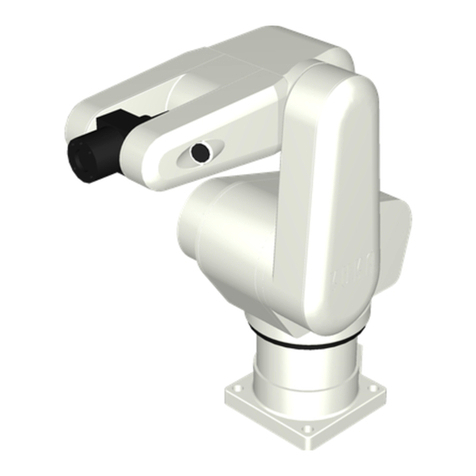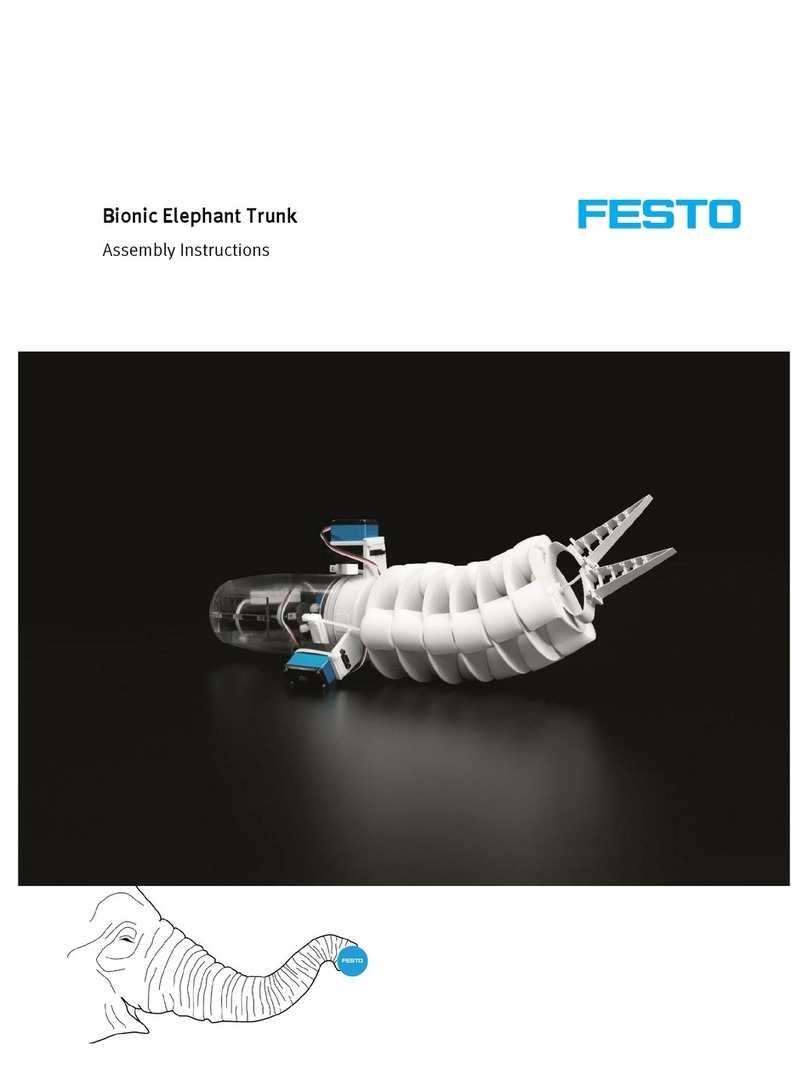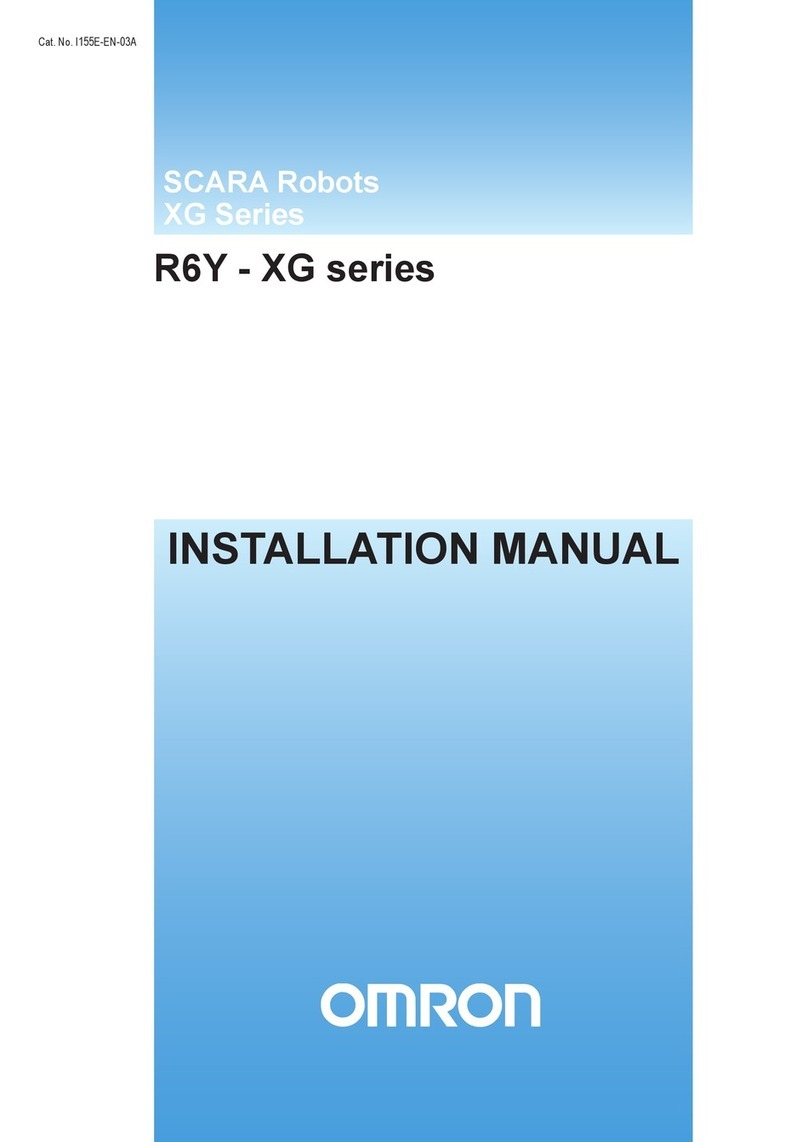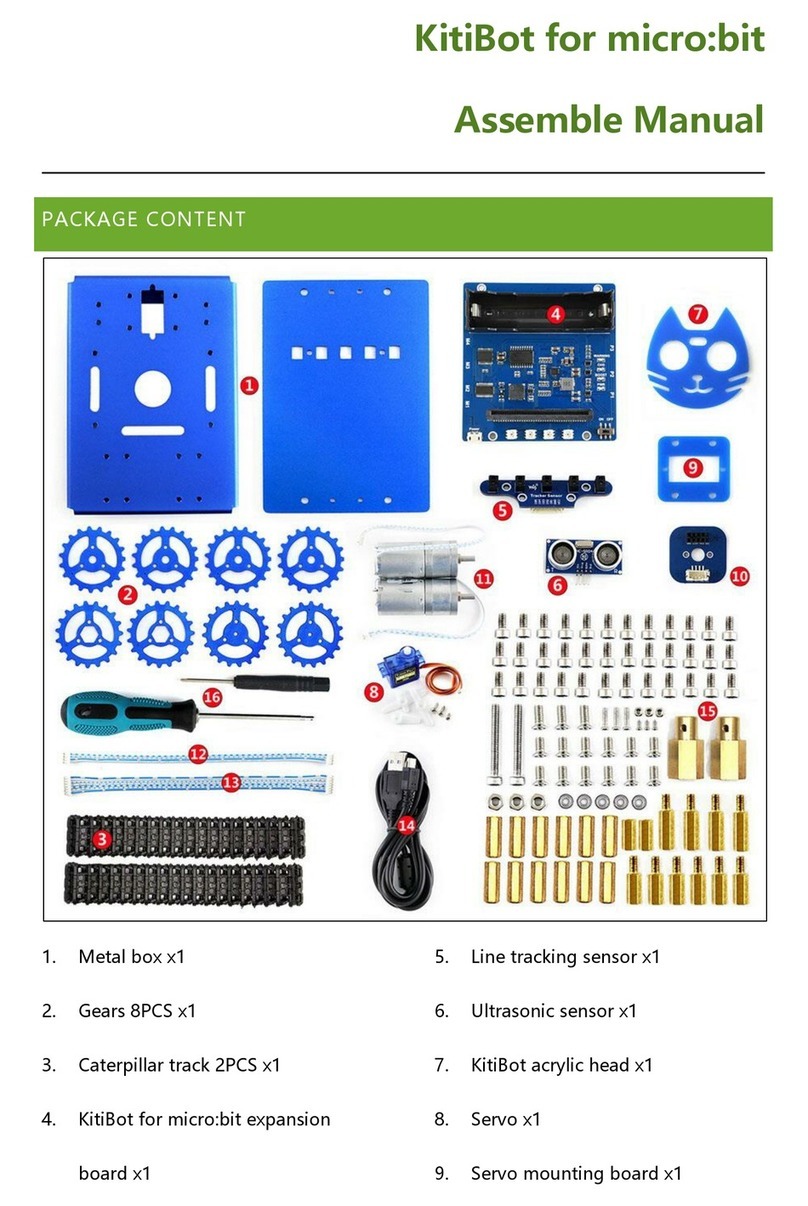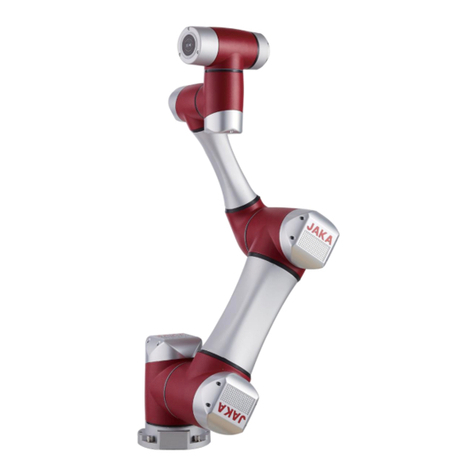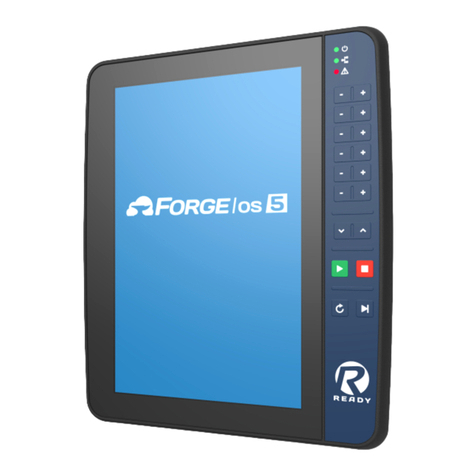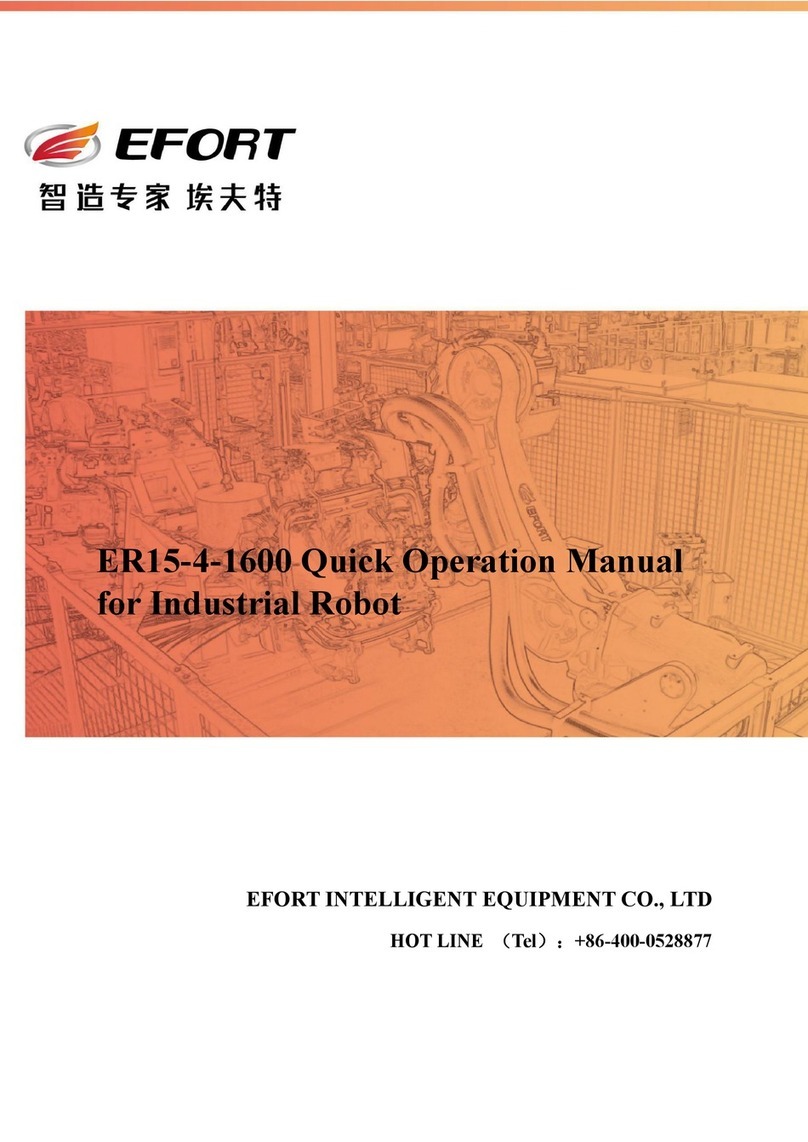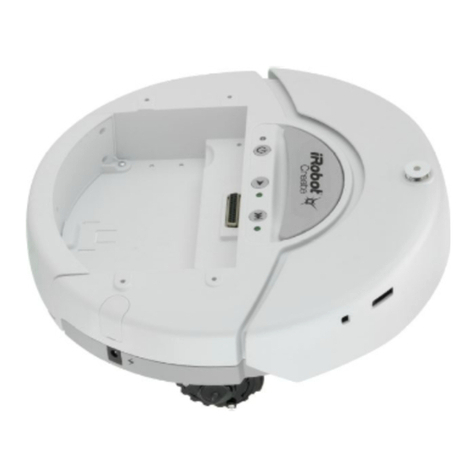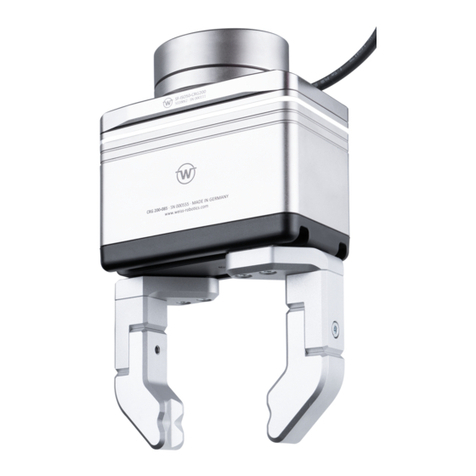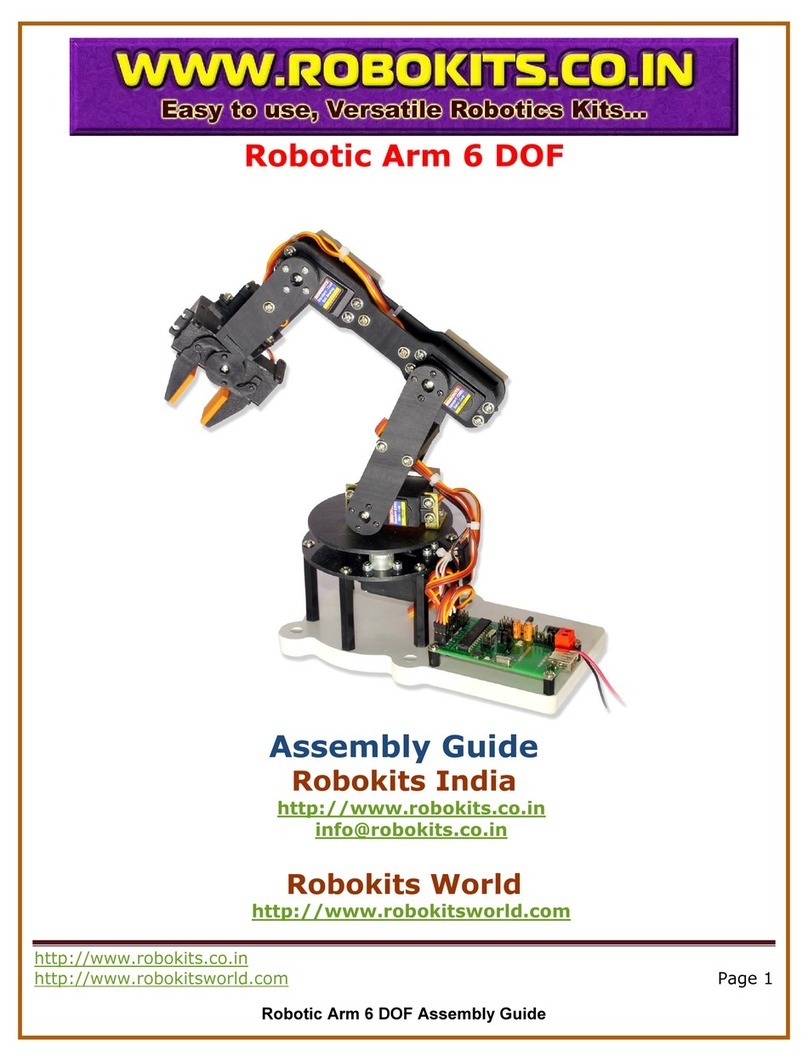RoboSense RS-Helios-1610 User manual

RS-Helios-1610 User Manual
RS-Helios-1610

RS-Helios-1610 User Manual
I
Revision History
Issue
Modifications
Release Date
Edited by
1.0.0
Original issue
2022-08-31
PD

RS-Helios-1610 User Manual
II
Terminologies
MSOP
Main data Stream Output Protocol
DIFOP
Device Info Output Protocol
FOV
Field Of View
PTP
Precision Time Protocol
NTP
Network Time Protocol
GPS
Global Positioning System
UTC
Universal Time Coordinated
Wave_mode
Echo flag
Protocol
Protocol version number, 00 represents old version, 01 represents the latest
version
Temp
Sensor temperature information
Resv
Reserved data flag
Azimuth
LiDAR horizontal rotation angle
Timestamp
Time stamp which is used to record system time
Header
Frame header in protocol packet
Tail
Frame tail in protocol packet
Value
The decimal value obtained after conversion of the corresponding offset byte,
using big-endian mode, with the high bit in the front and the low bit in the
back

RS-Helios-1610 User Manual
III
Content
1 Safety Notices..............................................................................................................................................................1
2 Helios Series Products .............................................................................................................................................. 2
3 Product Appearance and Interface...................................................................................................................... 3
3.1 Product Appearance.................................................................................................................................... 3
3.2 Aviation Plug and Pin Definition.............................................................................................................. 3
3.3 Interface Box...................................................................................................................................................4
4 Unboxing & Installation............................................................................................................................................6
4.1 Standard Package ..........................................................................................................................................6
4.2 Sensor Mounting...........................................................................................................................................6
4.3 Quick Connection ..........................................................................................................................................8
5 Sensor Specifications and Features...................................................................................................................10
5.1 Sensor Specification..................................................................................................................................10
5.1.1 Parameters......................................................................................................................................10
5.2 Point Cloud Display....................................................................................................................................12
5.2.1 Coordinate Mapping....................................................................................................................12
5.3 Reflectivity....................................................................................................................................................12
5.4 Laser Return Modes .................................................................................................................................. 13
5.4.1 Principle of Laser Return Modes............................................................................................. 13
5.4.2 Return Mode Flag.........................................................................................................................14
5.5 Phase Locking.............................................................................................................................................. 14
5.6 Time Synchronization............................................................................................................................... 15
5.6.1 GPS Time Synchronization.........................................................................................................15
5.6.2 The Use of GPS for Time Synchronization............................................................................15
5.6.3 PTP Time Synchronization......................................................................................................... 16
5.6.4 PTP wiring Method.......................................................................................................................17
6 Communication Protocol...................................................................................................................................... 17
6.1 MSOP and DIFOP........................................................................................................................................18
6.2 Main Data Stream Output Protocol(MSOP)............................................................................... 18
6.2.1 Header ..............................................................................................................................................18
6.2.2 Data Blocks......................................................................................................................................19
6.2.3 Tail......................................................................................................................................................21
6.3 Device Info Output Protocol(DIFOP).............................................................................................22
7 Vertical Angles and Precision Point Timing Calculation ..............................................................................24
7.1 Channel Number and Vertical Angle ................................................................................................... 24
7.2 Exact Point Timing Calculation.............................................................................................................. 24
8 Troubleshooting ....................................................................................................................................................... 26
Appendix A Web Interface....................................................................................................................................... 28
A.1 Device Screen..............................................................................................................................................28
A.2 Web Interface for Sensor Setting ......................................................................................................... 28
A.3 Diagnostic Screen ...................................................................................................................................... 31
A.4 System Screen.............................................................................................................................................32
Appendix B Information Registers.........................................................................................................................34

RS-Helios-1610 User Manual
IV
B.1 Motor Speed (MOT_SPD) ........................................................................................................................34
B.2 Ethernet(ETH).......................................................................................................................................34
B.3 FOV Setting(FOV_SET)....................................................................................................................... 35
B.4 Motor Phase Offset (MOT_PHASE)......................................................................................................35
B.5 Top Board Firmware Version (TOP_FRM).......................................................................................... 35
B.6 Bottom Board Firmware Version(BOT_FRM)....................................................................................36
B.7 Motor Firmware Version(MOT_FRM)................................................................................................. 36
B.8 Software Version(SOF_FRM)..................................................................................................................36
B.9 Corrected Vertical Angle(COR_VERT_ANG) ...................................................................................... 37
B.10 Corrected Horizontal Angle(COR_HOR_ANG)............................................................................ 38
B.11 Serial Number(SN)............................................................................................................................... 39
B.12 Software Version(SOFTWARE_VER)........................................................................................... 39
B.13 UTC Time(UTC_TIME)......................................................................................................................39
B.14 STATUS(STATUS).................................................................................................................................40
B.15 Fault Diagnosis(FALT_DIGS)...........................................................................................................40
B.16 GPRMC Data Packet-ASCII Code Data Type.................................................................................... 42
Appendix C RSView.....................................................................................................................................................43
C.1 Software Features......................................................................................................................................43
C.2 Install RSView.............................................................................................................................................. 43
C.3 Set Up Network.......................................................................................................................................... 44
C.4 Visualize Streaming Sensor Data.......................................................................................................... 44
C.5 Capture Streaming Sensor Data to PCAP File ...................................................................................45
C.6 Replay PCAP File .........................................................................................................................................45
C.7 Set RSView Data Port................................................................................................................................ 48
Appendix D RS-Helios ROS&ROS2 Package........................................................................................................ 49
D.1 Install Software...........................................................................................................................................49
D.2 Download & Compile RoboSense LiDAR Driver Package............................................................. 49
D.3 Configure PC IP........................................................................................................................................... 50
D.4 Real Time Display.......................................................................................................................................50
D.5 View Offline Data.......................................................................................................................................51
Appendix E Mechanical Drawings......................................................................................................................... 52
Appendix F Sensor Cleaning .................................................................................................................................... 53
F.1 Attention........................................................................................................................................................53
F.2 Required Materials.....................................................................................................................................53
F.3 Cleaning Method ........................................................................................................................................ 53

RS-Helios-1610 User Manual
V
1. Manufacturer Information
Suteng Innovation Technology Co., Ltd. (RoboSense)
Building 9, Block 2, Zhongguan Honghualing Industry Southern District, 1213 Liuxian Avenue,
Taoyuan Street, Nanshan District, Shenzhen, ChinaLandline: 0755-86325830
Mobile Phone: +86 15338772453(Marketing & Sales Cooperation)
Email: service@robosense.cn
Working hours from Monday to Friday 09:00-18:00(GMT/UTC +8)
2 Disclaimer of Liability
This manual is protected by copyright. Any rights arising from this copyright are owned by
RoboSense. Reproduction of this manual or part of the manual is only permitted within the legal
scope of the copyright law. Without obtaining any authorization, this document shall not be
abridged or translated. The trademarks mentioned in this document are the property of their
respective owners. RoboSense reserves all rights.
3 Certifications
Note:
This manual is updated from time to time without prior notice, to get the latest version, please
visit RoboSense company website to download or contact the RoboSense Technical Support or
Sales.

RS-Helios-1610 User Manual
1
1 Safety Notices
To avoid risks of accidents, damage to sensor or violating of your product warranty, please read
and follow the instructions in this manual carefully before operating the product.
Laser Safety
This product meets the following standards for laser products:
IEC 60825-1:2014;
Please pay attention to the overheating sign on the LiDAR surface to avoid a hot LiDAR
surface that may lead to sensor failure or undesirable consequences.
Retain Instructions - The safety and operating instructions should be retained for future
reference.
Heed Warnings - All warnings on the product and in the operating instructions should be
adhered to.
Servicing – Except for what’s described in this manual, the sensor has no field serviceable
parts. For servicing, please contact RoboSense sales or the authorized distributors.

RS-Helios-1610 User Manual
2
2 Helios Series Products
No.
Model
Number of Channels
FOV
Remark
1
RS-Helios-5515
32
-55°~+15°
Wide FOV
2
RS-Helios-1615
32
-16°~+15°
Uniform 1° Vertical Resolution
3
RS-Helios-1610
32
-16°~+10°
up to 0.5°
4
RS-Helios-16P
16
-15°~+15°
Uniform 2° Vertical Resolution
This manual is for the RS-Helios-1610 product.

RS-Helios-1610 User Manual
3
3 Product Appearance and Interface
3.1 Product Appearance
Figure 1 LiDAR Coordinate and Rotation Direction
3.2 Aviation Plug and Pin Definition
RS-Helios-1610 has an aviation plug attached to the bottom of the LiDAR, the definitions of the
specific pins of the aviation plug are as shown in the table below:
Pin
Color
Function
Operating Voltage Range
Working Current
Other
1
Red
PWR
9~32V
1.2A
/
2
Black
PWR
3
Gray
GND
/
1.2A
4
Blue
GND
5
Brown
GPS_PPS
3~15V
/
6
White
GPS_GPRMC
-15V~+15V
Aviation plug interface side

RS-Helios-1610 User Manual
4
Figure 2 Definition of Pins of Aviation Plug
3.3 Interface Box
Your RS-Helios-1610 comes with an Interface Box, which has 2 LED lights and provides convenient
connections to power, RJ45 Ethernet, and GPS. (The length of the integrated cable attached to
the Interface Box of the aviation plug version LiDAR is 3 meters, for other cable lengths, please
contact RoboSense technical support).
Figure 3 Definition of Interface Box Ports
Specifications of Interface Box ports:
Table 1 Interface Box Port Specification
No.
Port
Specification
1
Power Input
Standard DC 5.5-2.1 connector
2
Network
Standard RJ45 Ethernet connector
3
GPS timing
SH1.0-6P Female connector
3.3.1 Power
The power supply interface on the Interface Box is a standard DC 5.5-2.1 connector.
There are 2 LEDs in the Interface Box: when the power input is normal, the red LED lights up;
7
Purple
SYNC_OUT1
0~3.3V
8
Green
SYNC_OUT2
9
Orange
TRD_N
Twisted Pair
10
Yellow
TRD_P

RS-Helios-1610 User Manual
5
when the power output is normal, the green LED lights up. If the power indicator is dimmed, the
Interface BOX may not work properly. Please check whether the power input is normal. If the
power input is normal, the Interface BOX may be damaged. Please contact our technical support
& sales.
3.3.2 RJ45 Ethernet Port
The network interface on the Interface Box follows the EIA/TIA568 standard.
3.3.3 GPS Time Synchronization
RS-Helios-1610 uses GPS for Time Synchronization: the GPS REC receives GPS UART standard input; GPS PULSE
receives GPS PPS information input.
The definitions of pins of the GPS port are detailed in the figure below:
Table 2 GPS Port Definition
Pin No.
Function
1
GPS_PPS
2
+5V
3
GND
4
GPS_GPRMC
5
GND
6
SYNC_OUT1
Note: When the "ground" of RS-Helios-1610 is connected to an external system, the negative polarity ("ground")
of the external system and the "ground" of the GPS system must share a non-isolated common ground.

RS-Helios-1610 User Manual
6
4 Unboxing & Installation
4.1 Standard Package
The table below lists the contents of a standard RS-Helios-1610 package from the factory.
Table 3 Standard Factory Package of the RS-Helios-1610
No.
Contents
SPEC/QTY
1
LiDAR
RS-Helios-1610*1
2
Interface Box
3M *1
3
Power Adapter
DC12Vx3.34A/40W *1
4
Power Cable
1.2M *1
5
Ethernet Cable
1.5M *1
6
Screw Pack
M3X8 *4, M3X12 *4
Note: There might be variants of the sensor and accessories that you are going to purchase or interested in,
please contact RoboSense Sales for details.
4.2 Sensor Mounting
Figure 4 LiDAR Mounting Details
Screw Specifications
GB/T70.1, M3x12, hexagon socket head, material SCM435, electroplated trivalent chromium
3xM3 Screws, 4-5mm above mounting surface;
13±1kgf.cm recommended tightening torque
2xΦ4 locating pins, 4-5mm above mounting surface

RS-Helios-1610 User Manual
7
black zinc, grade 10.9, with drop resistance coating.
GB/T70.1, M3x8, hexagon socket head, material SCM435, electroplated trivalent chromium black
zinc, grade 10.9, with drop resistance coating.
Mounting Requirements
1) The mounting surface should be as flat as possible with the flatness be better than 0.05mm;
2) Use 3xM3 mounting screws to fix the LiDAR on the mounting surface, the screw should be
4~5mm above the mounting surface, the recommended tightening torque is 13±1kgf.cm;
3) Use 2xΦ4 locating pins to locate the LiDAR on the mounting surface, the pin should be
4~5mm above the mounting surface.
Figure 5 LiDAR Mounting Holes & Locating Holes Diagram
Mounting Bracket Rigidity Requirements
The mounting bracket where the LiDAR is attached to should be rigid enough to ensure LiDAR in a
stable operating state under various working conditions. Therefore, it is required that the
first-order modal frequency of the LiDAR and the mounting bracket should be greater than 50Hz,
and avoiding frequency range of 100~110Hz and 280-290Hz;
The LiDAR will be subjected to various random vibrations, mechanical shocks and other operating
conditions during use. Under these conditions, the bracket needs to be strong enough to bear a
relatively large load.
The following situations should be avoided when mounting the LiDAR:
1) The mounting surface of the LiDAR should be flat and uneven surfaces should be avoided.
2) The precise locator pins on the mounting base should strictly follow the dimensions of the
2 x Φ4 Locating holes
3 x M3 Mounting holes

RS-Helios-1610 User Manual
8
locator holes at the bottom of the LiDAR, and the height of the locator pin should not be
higher than 4mm. We recommend using aluminum alloy for the mounting base material,
which facilitates heat dissipating of the LiDAR during operating.
3) If there are contact mounting surfaces on the top and bottom of the LiDAR, please ensure
that the distance between the mounting surfaces is greater than the height of the LiDAR to
avoid squeezing the LiDAR.
4) When connecting cables of the LiDAR, make sure not to pull the cable too tightly, and keep
the cables in a slack state.
4.3 Quick Connection
Users are allowed to configure the network settings of the RS-Helios-1610, which is set at the
factory with default IP and port numbers, as shown in the table below:
Table 4 Factory Default Network Configuration
IP Address
MSOP Port No.
DIFOP Port No.
RS-Helios-1610
192.168.1.200
6699
7788
Computer
192.168.1.102
To establish communication between the LiDAR and computer, it’s required to set the computer's
IP address to the same network segment as the LiDAR, for example 192.168.1.x (the value of x
could be from 1 to 254), and the subnet mask to 255.255.255.0. If you don't know the network
configuration of the LiDAR, please connect the LiDAR to computer and use wireshark to capture
the LiDAR data packets to analyze.

RS-Helios-1610 User Manual
9
The wiring diagram of the Interface Box connection is as shown in the figure below:
Figure 6 Interface Box Connection
Interface Box

RS-Helios-1610 User Manual
10
5 Sensor Specifications and Features
5.1 Sensor Specification1
5.1.1 Parameters
Sensor
Laser Channels
32
FOV(Horizontal)
360°
Laser Wavelength
905nm
FOV(Vertical)
﹢10° to -16°
(32° in total)
Laser Emission Angle
(Full Angel)
Horizontal: 0.5mrad
Vertical: 0.4mrad
Angular Resolution
(Horizontal)
0.2°/ 0.4°
Laser Safety
Class 1 Eye-safe
Angular Resolution
(Vertical)
Up to 0.5°
Measurement Range2
0.2m to 150m (90m @10%
Reflectivity NIST, refer to Table 3)
Ranging Accuracy
(Typical)3
±2cm
Blind Distance
0.2m
Frame Rate
10Hz/ 20 Hz
Rotation Speed
600/ 1200rmp(10/20Hz)
Output
Data Rate
576,000pts/s (Single Return Mode);
1,152,000pts/s(Dual Return Mode)
Ethernet
100M-Base-T1
Data Output Protocol
UDP packets over Ethernet
UDP Packets Content
3D Coordinates, Calibrated Reflectivity
Measurements, Time Stamps
Mechanical
Operating Voltage
9V - 32V
Dimension
φ97.5mm * H100
mm
Power Consumption4
12W(Typical); 20W(Peak)
Operating Temperature5
-30℃to +60℃
1The data above is only for serial production products, and may not be applicable to any samples, testing devices and other
non-production versions. If you have any questions, please contact RoboSense Sales.
2The ranging accuracy takes a 50% NIST diffuse reflector as the target. The test results may be affected by environment conditions,
including but not limited to factors such as ambient temperature and target distance.
3The accuracy value is applicable to most channels, and there may exists differences between some channels.
4The power consumption of the device may be affected by environment conditions, including but not limited to factors such as ambient
temperature, target distance, target reflectivity, etc.
5The operating temperature of the device may be affected by environment conditions, including but not limited to factors such as

RS-Helios-1610 User Manual
11
Weight
0.99kg(LiDAR body)
Storage Temperature
-40℃to +85℃
Time Synchronization
$GPRMC with 1PPS,PTP&gPTP
Sensor Protection
IP67
Table 5 Ranging Capability of LiDAR Channel
Channel No.
Vertical Angle(°)
10% NIST(m)
Range(m)
16
10°
50
150
32
7°
50
150
14
5°
90
150
30
3.5°
90
150
31
3°
90
150
7
2.5°
90
150
12
2°
90
150
23
1.5°
90
150
15
1°
90
150
28
0.5°
90
150
29
0°
90
150
5
-0.5°
90
150
10
-1°
90
150
21
-1.5°
90
150
13
-2°
90
150
26
-2.5°
90
150
27
-3°
90
150
3
-3.5°
90
150
8
-4°
90
150
19
-4.5°
90
150
11
-5°
90
150
24
-5.5°
90
150
25
-6°
90
150
1
-6.5°
90
150
6
-7°
50
150
9
-8°
50
150
22
-9°
50
150
4
-10°
50
150
17
-11°
50
150
20
-12°
50
150
2
-13.5°
50
150
18
-16°
50
150
ambient light and airflow changes.

RS-Helios-1610 User Manual
12
5.2 Point Cloud Display
5.2.1 Coordinate Mapping
Since the data packet output by the LiDAR only provides the horizontal rotation angle and
distance parameters, in order to present a 3D point cloud image, the angle and distance
information in polar coordinates need to be converted into x, y, z coordinates in the Cartesian
coordinate system, and the conversion formula is as follows:
Where is the measured distance,
is the vertical angle of the laser,
is the horizontal
rotation angle of the laser in the Polar Coordinate System, and x, y, z are the coordinate values in
the Cartesian Coordinate System.
Note 1: ROS source code of RS-Helios-1610 has by default completed the coordinate conversion to conform to the
right-handed coordinate system of ROS. The X-axis of ROS is the positive Y direction in Figure 1, and the Y-axis of
ROS is the negative X direction in Figure 1.
Note 2: The origin of the LiDAR sensor coordinate is 63.5mm above the LiDAR base, on the center axis.
5.3 Reflectivity
RS-Helios-1610 measures the reflectivity of objects. The reflectivity is an index that measures the
ability of an object to reflect light and is greatly related to the material of the object itself.
Therefore, the reflectivity information can be used to distinguish objects of different materials.
RS-Helios-1610 reports calibrated reflectivity values from 0 to 255, among which diffuse
reflectors report values from 0 to 100, and retroreflectors report values from 101 to 255. Black
objects are with low reflectivity values, white objects are with high reflectivity values, the most
ideal reflection reports the reflectivity value of 255.
Diffuse Reflectors

RS-Helios-1610 User Manual
13
Figure 7 Definition of Reflectivity
5.4 Laser Return Modes
5.4.1 Principle of Laser Return Modes
RS-Helios-1610 supports multiple laser return modes, namely: Strongest, Last, First and Dual.
When set to Dual Return mode, the details of the target will increase, and the volume of data is
twice that in the Single Return mode.
Due to beam divergence, multiple laser returns are possible from any single laser shot. After a
laser pulse is hot, the beam size becomes larger and larger as it travels in the air, when a beam is
large enough to hit multiple objects, it will produce multiple reflections.
RS-Helios-1610 analyzes the received multiple returns, and can be set to only report the strongest
return, first return or the last return each time in the single return mode, or report the strongest
and last return, the strongest and first return, or the first and the last return at the same time in
dual return mode, depending on the laser return mode settings. If it is set to the strongest return
mode, only the value of strongest return will be reported. Similarly, if is set to the last return
mode, only the value of the last return will be reported.
Note:
Black, absorbent diffuse reflector
Reflectivity ≈0
White, reflective diffuse reflector
Reflectivity <100
Retro-Reflectors
Retro-reflector covered with
semi-transparent white surface
Reflectivity>100
Retro-reflector without any
coverage
Reflectibity≈255

RS-Helios-1610 User Manual
14
1. The sensor records both returns only when the distance between two objects is 1 meter or more.
2. When a laser pulse hits only one object, there is only the strongest return.
3. When a laser pulse hits two solid walls or other objects at two different distances, two returns will be produced.
In this case, there are two situations:
(1) When the strongest return is not the last return, the strongest and last return will be reported;
(2) When the strongest return is the last return, the strongest return and the second strongest return will be
reported.
5.4.2 Return Mode Flag
The RS-Helios-1610 is set in the Strongest Return mode at factory by default. If you need to
change this settings, please refer to Appendix A.2 of this user manual for instructions. The 300th
byte in a DIFOP packet is the flag of return mode, which corresponds to the following:
Table 6 Return Mode Flag
Flag
Return Mode
00
Dual Return
04
Strongest Return
05
Last Return
06
First return
5.5 Phase Locking
The phase locking feature, when a PPS pulse signal is triggered, askes the RS-Helios-1610 to
rotate to a specific angle to fire laser pulses. When multiple RS-Helios-1610 sensors are used at
the same time, the relative rotation angle between them is kept unchanged. The normal phase
locking requires the normal and stable PPS pulse triggering signal.
Figure 8 shows the RS-Helios-1610 set with different phases. The red arrows indicate the firing
angle of the sensor’s laser at the moment it receives the rising edge of the PPS signal. In the cases
below: 0 degrees, 135 degrees, and 270 degrees respectively.
Figure 8 RS-Helios-1610 Different Phase Settings
Table of contents
Other RoboSense Robotics manuals
